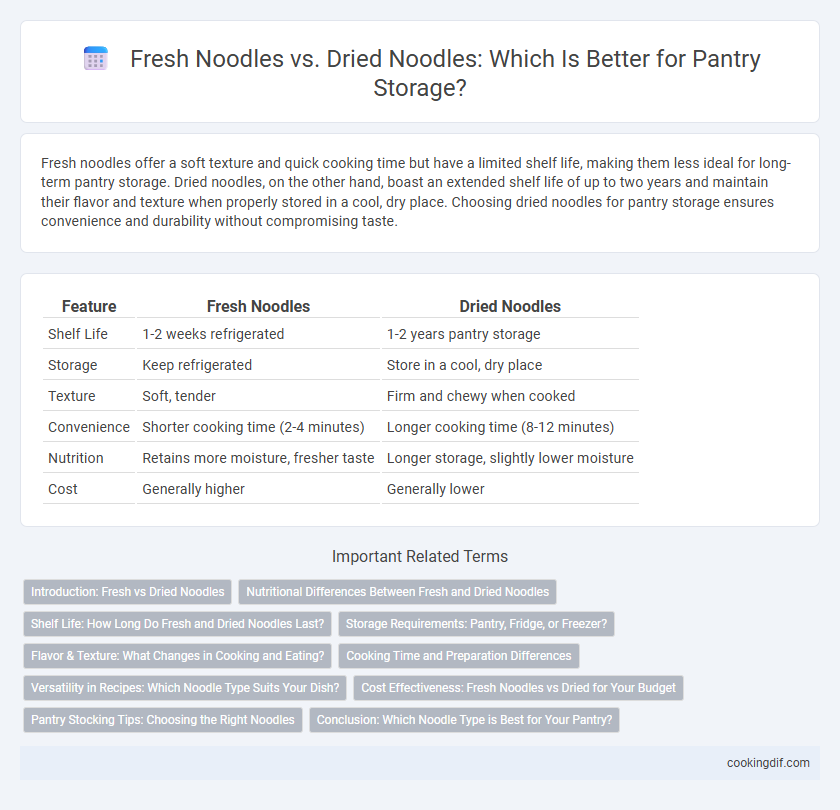Fresh noodles offer a soft texture and quick cooking time but have a limited shelf life, making them less ideal for long-term pantry storage. Dried noodles, on the other hand, boast an extended shelf life of up to two years and maintain their flavor and texture when properly stored in a cool, dry place. Choosing dried noodles for pantry storage ensures convenience and durability without compromising taste.
Table of Comparison
| Feature | Fresh Noodles | Dried Noodles |
|---|---|---|
| Shelf Life | 1-2 weeks refrigerated | 1-2 years pantry storage |
| Storage | Keep refrigerated | Store in a cool, dry place |
| Texture | Soft, tender | Firm and chewy when cooked |
| Convenience | Shorter cooking time (2-4 minutes) | Longer cooking time (8-12 minutes) |
| Nutrition | Retains more moisture, fresher taste | Longer storage, slightly lower moisture |
| Cost | Generally higher | Generally lower |
Introduction: Fresh vs Dried Noodles
Fresh noodles have higher moisture content, making them prone to spoilage and requiring refrigeration, while dried noodles are dehydrated for extended shelf life, ideal for pantry storage. Nutritionally, fresh noodles often retain more natural flavor and texture, whereas dried noodles offer convenience and versatility with a longer expiration date. Selecting between fresh and dried noodles depends on storage capacity, cooking preferences, and the desired culinary outcome.
Nutritional Differences Between Fresh and Dried Noodles
Fresh noodles retain higher moisture content and often preserve more vitamins like B-complex and antioxidants due to minimal processing, whereas dried noodles undergo dehydration that slightly reduces vitamin levels but concentrates carbohydrates and protein. Both types provide similar calorie counts, with dried noodles offering longer shelf stability ideal for pantry storage without refrigeration. Texture and cooking time vary, but nutritional differences are subtle, making each suitable for balanced diets depending on convenience and storage needs.
Shelf Life: How Long Do Fresh and Dried Noodles Last?
Fresh noodles typically last 2 to 5 days in the refrigerator due to their high moisture content, making them perishable and requiring prompt use. Dried noodles have a significantly longer shelf life, often ranging from 1 to 2 years when stored in a cool, dry place, benefiting from low moisture and airtight packaging. Proper storage conditions for dried noodles help maintain their quality and prevent spoilage, making them ideal for pantry storage over fresh noodles.
Storage Requirements: Pantry, Fridge, or Freezer?
Fresh noodles require refrigeration or freezing to maintain their moisture content and prevent spoilage, making them less suitable for pantry storage. Dried noodles have a low moisture level, allowing safe and long-term storage at room temperature in a sealed pantry container. Proper storage of dried noodles in a cool, dry pantry extends shelf life to 1-2 years, while fresh noodles typically last only a few days refrigerated or several weeks frozen.
Flavor & Texture: What Changes in Cooking and Eating?
Fresh noodles deliver a tender, delicate texture and rich, wheaty flavor that intensifies during quick cooking, offering a more authentic and vibrant eating experience. Dried noodles, with their denser, firmer bite, undergo a longer cooking process that enhances their chewiness and develops a slightly toasted taste, ideal for hearty dishes. Flavor absorption varies as fresh noodles soak up sauces rapidly, while dried noodles provide a resilient texture that balances robust flavors throughout the meal.
Cooking Time and Preparation Differences
Fresh noodles cook in 2 to 4 minutes due to their higher moisture content, while dried noodles require 8 to 12 minutes, as they need rehydration. Preparing fresh noodles involves minimal soaking and is ideal for quick meals, whereas dried noodles must be boiled longer but offer extended shelf life in pantry storage. The choice between fresh and dried noodles impacts both cooking efficiency and storage convenience, crucial for meal planning.
Versatility in Recipes: Which Noodle Type Suits Your Dish?
Fresh noodles offer a tender texture and quick cooking time, making them ideal for delicate dishes like stir-fries and soups where a soft bite enhances the flavor profile. Dried noodles provide longer shelf life and a chewier texture that holds up well in robust recipes such as pasta salads, baked casseroles, and hearty sauces. Choosing between fresh and dried noodles depends on your recipe's cooking time, desired texture, and storage convenience, ensuring optimal taste and culinary versatility.
Cost Effectiveness: Fresh Noodles vs Dried for Your Budget
Dried noodles offer superior cost-effectiveness for pantry storage due to their longer shelf life and lower price per serving compared to fresh noodles. While fresh noodles provide a richer texture and flavor, their higher cost and limited refrigeration requirements make them less economical for bulk purchasing. Choosing dried noodles helps maintain budget efficiency without sacrificing versatility in meal preparation.
Pantry Stocking Tips: Choosing the Right Noodles
Fresh noodles offer superior texture and flavor but have a shorter shelf life, making them ideal for immediate use or refrigerated storage. Dried noodles provide long-lasting pantry stability, maintaining quality for months and allowing flexible meal planning. For pantry stocking, prioritize dried noodles to ensure a versatile, long-term staple while reserving fresh noodles for quick, specialty dishes.
Conclusion: Which Noodle Type is Best for Your Pantry?
Fresh noodles offer superior texture and flavor but have a limited shelf life, making them ideal for immediate consumption or refrigeration. Dried noodles provide unmatched longevity and convenience for pantry storage, maintaining quality for several months when kept in a cool, dry place. For pantry storage, dried noodles are the best choice due to their durability, ease of storage, and versatility in various recipes.
Fresh noodles vs Dried noodles for pantry storage Infographic

 cookingdif.com
cookingdif.com